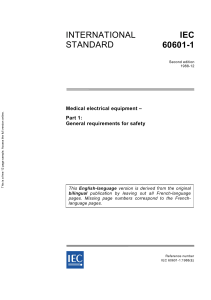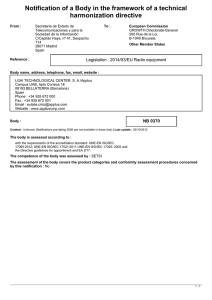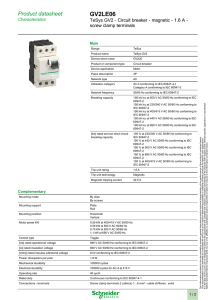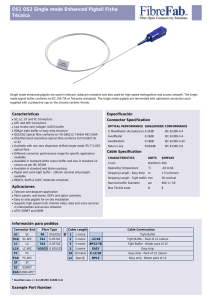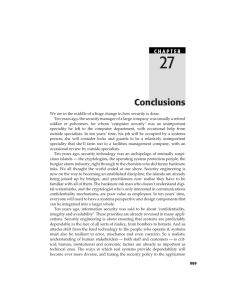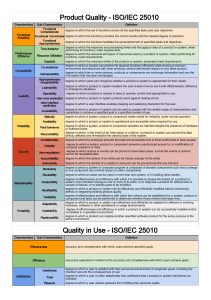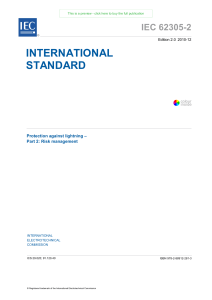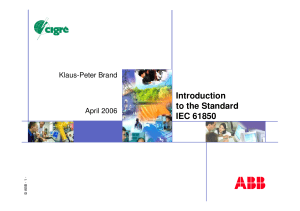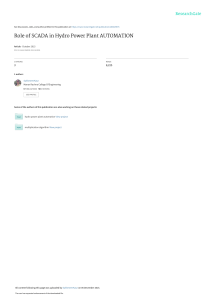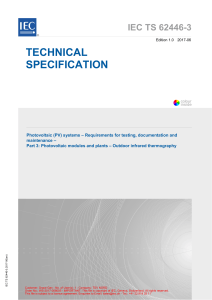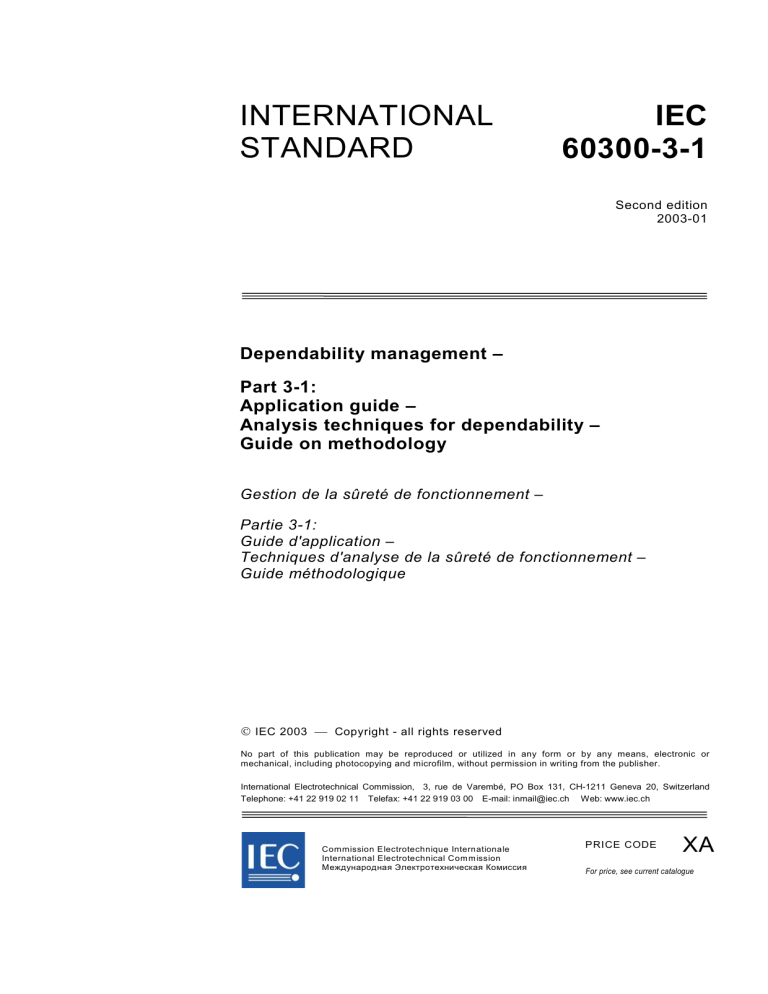
INTERNATIONAL STANDARD IEC 60300-3-1 Second edition 2003-01 Dependability management – Part 3-1: Application guide – Analysis techniques for dependability – Guide on methodology Gestion de la sûreté de fonctionnement – Partie 3-1: Guide d'application – Techniques d'analyse de la sûreté de fonctionnement – Guide méthodologique IEC 2003 Copyright - all rights reserved No part of this publication may be reproduced or utilized in any form or by any means, electronic or mechanical, including photocopying and microfilm, without permission in writing from the publisher. International Electrotechnical Commission, 3, rue de Varembé, PO Box 131, CH-1211 Geneva 20, Switzerland Telephone: +41 22 919 02 11 Telefax: +41 22 919 03 00 E-mail: inmail@iec.ch Web: www.iec.ch Com mission Electrotechnique Internationale International Electrotechnical Com m ission Международная Электротехническая Комиссия PRICE CODE XA For price, see current catalogue –2– 60300-3-1 IEC:2003(E) CONTENTS FOREWORD .......................................................................................................................... 3 INTRODUCTION .................................................................................................................... 4 1 Scope .............................................................................................................................. 5 2 Normative references....................................................................................................... 5 3 Definitions ....................................................................................................................... 6 4 Basic dependability analysis procedure............................................................................ 7 5 4.1 General procedure .................................................................................................. 7 4.2 Dependability analysis methods .............................................................................. 8 4.3 Dependability allocations .......................................................................................10 4.4 Dependability analysis ...........................................................................................11 4.5 Maintenance and repair analysis and considerations .............................................13 Selecting the appropriate analysis method ......................................................................13 Annex A (informative) Brief description of analysis techniques .............................................16 Bibliography ..........................................................................................................................58 Figure 1 – General dependability analysis procedure ............................................................. 7 Figure A.1 – Temperature dependence of the failure rate ......................................................19 Figure A.2 – Fault tree for an audio amplifier.........................................................................21 Figure A.3 – Sub-tree from FTA in Figure A.2........................................................................22 Figure A.4 – Event tree .........................................................................................................24 Figure A.5 – Elementary models............................................................................................26 Figure A.6 – Example of unit .................................................................................................28 Figure A.7 – State-transition diagram ....................................................................................29 Figure A.8 – Block diagram of a multiprocessor system.........................................................32 Figure A.9 – Petri net of a multiprocessor system..................................................................33 Figure A.10 – The HAZOP study procedure...........................................................................37 Figure A.11 – Human errors shown as an event tree .............................................................41 Figure A.12 – Example – Application of stress–strength criteria ............................................43 Figure A.13 – Truth table for simple systems.........................................................................44 Figure A.14 – Example ..........................................................................................................44 Figure A.15 – Cause and effect diagram ...............................................................................56 Table 1 – Use of methods for general dependability analysis tasks ........................................ 9 Table 2 – Characteristics of selected dependability analysis methods ...................................15 Table A.1 – Symbols used in the representation of the fault treee .........................................22 Table A.2 – States of the unit ................................................................................................28 Table A.3 – Effects of failures in functional and diagnostic parts ...........................................29 Table A.4 – Transition rates ..................................................................................................30 Table A.5 – Example of FMEA...............................................................................................35 Table A.6 – Basic guide words and their generic meanings ...................................................36 Table A.7 – Additional guide words relating to clock time and order or sequence .................36 Table A.8 – Credible human errors ........................................................................................40 Table A.9 – Truth table example............................................................................................45 60300-3-1 IEC:2003(E) –3– INTERNATIONAL ELECTROTECHNICAL COMMISSION ____________ DEPENDABILITY MANAGEMENT – Part 3-1: Application guide – Analysis techniques for dependability – Guide on methodology FOREWORD 1) The IEC (International Electrotechnical Commission) is a worldwide organization for standardization comprising all national electrotechnical committees (IEC National Committees). The object of the IEC is to promote international co-operation on all questions concerning standardization in the electrical and electronic fields. To this end and in addition to other activities, the IEC publishes International Standards. Their preparation is entrusted to technical committees; any IEC National Committee interested in the subject dealt with may participate in this preparatory work. International, governmental and non-governmental organizations liaising with the IEC also participate in this preparation. The IEC collaborates closely with the International Organization for Standardization (ISO) in accordance with conditions determined by agreement between the two organizations. 2) The formal decisions or agreements of the IEC on technical matters express, as nearly as possible, an international consensus of opinion on the relevant subjects since each technical committee has representation from all interested National Committees. 3) The documents produced have the form of recommendations for international use and are published in the form of standards, technical specifications, technical reports or guides and they are accepted by the National Committees in that sense. 4) In order to promote international unification, IEC National Committees undertake to apply IEC International Standards transparently to the maximum extent possible in their national and regional standards. Any divergence between the IEC Standard and the corresponding national or regional standard shall be clearly indicated in the latter. 5) The IEC provides no marking procedure to indicate its approval and cannot be rendered responsible for any equipment declared to be in conformity with one of its standards. 6) Attention is drawn to the possibility that some of the elements of this International Standard may be the subject of patent rights. The IEC shall not be held responsible for identifying any or all such patent rights. International Standard IEC 60300-3-1 has been prepared by IEC technical committee 56: Dependability. This second edition cancels and replaces the first edition, published in 1991, and constitutes a full technical revision. In particular, the guidance on the selection of analysis techniques and the number of analysis techniques covered has been extended. The text of this standard is based on the following documents: FDIS Report on voting 56/825/FDIS 56/840/RVD Full information on the voting for the approval of this standard can be found in the report on voting indicated in the above table. This publication has been drafted in accordance with the ISO/IEC Directives, Part 2. The committee has decided that the contents of this publication will remain unchanged until 2007. At this date, the publication will be • reconfirmed; • withdrawn; • replaced by a revised edition, or • amended. –4– 60300-3-1 IEC:2003(E) INTRODUCTION The analysis techniques described in this part of IEC 60300 are used for the prediction, review and improvement of reliability, availability and maintainability of an item. These analyses are conducted during the concept and definition phase, the design and development phase and the operation and maintenance phase, at various system levels and degrees of detail, in order to evaluate, determine and improve the dependability measures of an item. They can also be used to compare the results of the analysis with specified requirements. In addition, they are used in logistics and maintenance planning to estimate frequency of maintenance and part replacement. These estimates often determine major life cycle cost elements and should be carefully applied in life cycle cost and comparative studies. In order to deliver meaningful results, the analysis should consider all possible contributions to the dependability of a system: hardware, software, as well as human factors and organizational aspects. 60300-3-1 IEC:2003(E) –5– DEPENDABILITY MANAGEMENT – Part 3-1: Application guide – Analysis techniques for dependability – Guide on methodology 1 Scope This part of IEC 60300 gives a general overview of commonly used dependability analysis techniques. It describes the usual methodologies, their advantages and disadvantages, data input and other conditions for using various techniques. This standard is an introduction to selected methodologies and is intended to provide the necessary information for choosing the most appropriate analysis methods. 2 Normative references The following referenced documents are indispensable for the application of this document. For dated references, only the edition cited applies. For undated references, the latest edition of the referenced document (including any amendments) applies. IEC 60050(191):1990, International Electrotechnical Vocabulary (IEV) – Chapter 191: Dependability and quality of service IEC 60300-3-2:1993, Dependability management – Part 3: Application guide – Section 2: Collection of dependability data from the field IEC 60300-3-4:1996, Dependability management – Part 3: Application guide – Section 4: Guide to the specification of dependability requirements IEC 60300-3-5:2001, Dependability management – Part 3-5: Application guide – Reliability test conditions and statistical test principles IEC 60300-3-10:2001, Maintainability Dependability management – Part 3-10: Application guide – IEC 60706-1:1982, Guide on maintainability of equipment – Part 1: Sections One, Two and Three – Introduction, requirements and maintainability programme IEC 60706-2:1990, Guide on maintainability of equipment – Part 2: Section Five – Maintainability studies during the design phase IEC 60812:1985, Analysis techniques for system reliability – Procedure for failure mode and effects analysis (FMEA) IEC 61078:1991, Analysis techniques for dependability – Reliability block diagram method IEC 61165:1995, Application of Markov techniques IEC 61709:1996, Electronic components – Reliability – Reference conditions for failure rates and stress models for conversion IEC 61882:2001, Hazard and operability studies (HAZOP studies) – Application guide ISO 9000:2000, Quality management systems – Fundamentals and vocabulary
